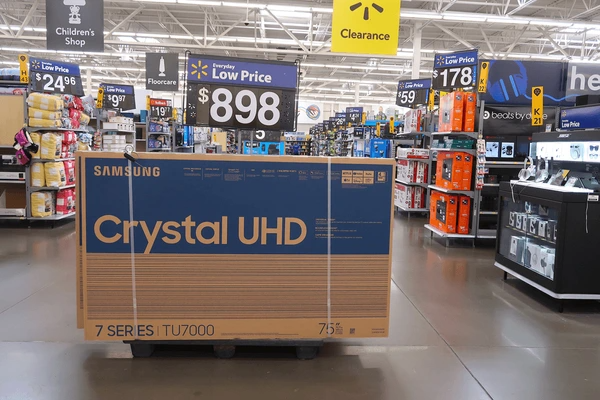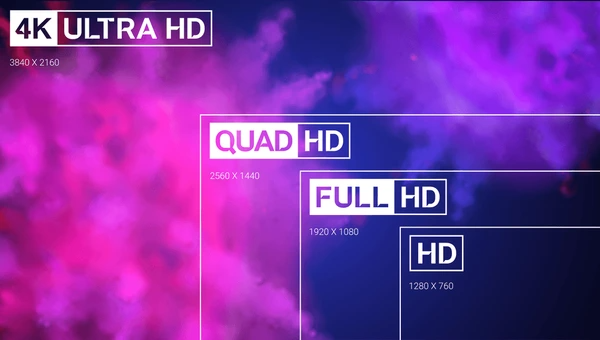
Introduction to QHD and UHD Resolutions
QHD (Quarter High Definition) and UHD (Ultra High Definition) are two advanced display resolutions that deliver superior image quality and detail compared to standard HD displays. These resolutions enhance visual clarity, making them ideal for gaming, streaming, and professional tasks. In this article, we’ll explore the key differences between QHD vs. UHD, their benefits, and how to choose the right resolution for your needs.
What Is QHD? Overview and Features
QHD, or Quad High Definition, offers a significant leap in resolution and image quality compared to standard HD displays (1920 x 1080). Its advanced features make it an excellent choice for professionals, gamers, and entertainment enthusiasts.

Higher Resolution for Crisp Visuals
QHD displays feature a resolution of 2560 x 1440 pixels, delivering four times the detail of standard HD. On a 27-inch monitor, this resolution translates to a pixel density of approximately 109 pixels per inch (PPI). This ensures sharper visuals and more defined details, making every image and text element look crystal clear.
Enhanced Image Quality
Thanks to the higher pixel density, QHD screens provide finer details, smoother edges, and improved color accuracy. These qualities make QHD displays ideal for tasks like graphic design, video editing, and photo retouching, where precision is essential.
Vibrant Colors with a Wide Color Gamut
Many QHD monitors support a wide color gamut, covering a broader spectrum of colors than standard displays. This results in more vibrant, lifelike visuals, which are crucial for color-sensitive applications like photography and video production.
💡 Curious about QHD? Eureka Technical Q&A offers a deep dive into its features, explaining how QHD displays enhance your viewing experience with sharper resolutions and vibrant colors, making them perfect for gaming, multimedia, and professional work.
Increased Workspace for Productivity
The higher resolution of QHD displays offers more on-screen space, allowing users to view multiple applications or windows simultaneously. This expanded workspace boosts productivity while maintaining excellent readability and image clarity.
Compatibility with High-Resolution Content
As high-resolution content, such as 4K videos and detailed images, becomes more common, QHD monitors are well-equipped to handle it. They deliver a more immersive viewing experience by showcasing this content with exceptional detail and clarity.
What Is UHD? Overview and Features
UHD, also called 4K or 8K, represents the next level of video technology. It offers better image quality and higher resolution compared to traditional HD formats. Let’s explore the key features that make UHD stand out.

Superior Resolution for Crisp Images
UHD delivers resolutions of 3840 x 2160 pixels (4K) and 7680 x 4320 pixels (8K). These resolutions are four and sixteen times sharper than Full HD (1920 x 1080). With this pixel density, images appear incredibly detailed and lifelike. Whether watching movies or gaming, UHD brings exceptional clarity to your screen.
Wider Color Gamut and Dynamic Range
UHD supports a broader color spectrum and higher dynamic range. This ensures more vibrant and accurate color reproduction. The improved contrast and brightness levels create a more immersive viewing experience. Everything on the screen looks closer to what you see in real life.
Smoother Motion with Higher Frame Rates
UHD supports frame rates as high as 120 frames per second (fps). In comparison, traditional HD typically runs at 24-60 fps. The higher frame rates eliminate motion blur and make fast-paced action look smoother. Sports events, action scenes, and gaming feel more realistic and engaging.
Efficient Bandwidth and Compression
UHD content requires more data due to its high resolution and quality. To manage this, modern compression techniques like HEVC (High Efficiency Video Coding) are used. These methods ensure UHD videos stream and store efficiently without losing quality.
QHD vs. UHD: Resolution and Clarity Comparison

Resolution: QHD vs. UHD
- QHD (Quad HD): Features a resolution of 2560 x 1440 pixels. It offers sharper images than Full HD (1920 x 1080 pixels).
- UHD (Ultra High Definition): Includes two resolutions:
- 4K UHD (3840 x 2160 pixels): Four times the resolution of Full HD.
- 8K UHD (7680 x 4320 pixels): Sixteen times the resolution of Full HD.
UHD provides unmatched sharpness and detail, making it ideal for large screens or close viewing.
Image Quality and Clarity
- Pixel Density: UHD displays pack more pixels into the same screen size, delivering finer details and smoother edges.
- Enhanced Textures: UHD can reproduce realistic textures and depth, offering lifelike visuals.
- Immersive Experience: The improved clarity is especially noticeable on larger screens and enhances overall immersion.
Advancements in Display Technology
- Color Accuracy: UHD supports wider color gamuts for vibrant and accurate color reproduction.
- Dynamic Range: Higher dynamic range improves contrast and brightness, adding more depth to visuals.
- Faster Refresh Rates: UHD displays often feature faster refresh rates, reducing motion blur and enhancing smoothness.
Compatibility and Adoption
- QHD Displays: Widely adopted in smartphones, tablets, and monitors.
- UHD Displays: Gaining popularity in TVs, monitors, and professional equipment.
- Challenges for UHD: Limited content, high bandwidth requirements, and hardware costs slow down widespread adoption.
Use Cases: Which Resolution Suits Your Needs
Everyday Computing and Office Work
- Best Choice: QHD
- Why: QHD provides excellent clarity for tasks like web browsing, document editing, and video conferencing. Its balance of sharpness and affordability makes it ideal for monitors and laptops used in office environments.
Gaming
- Best Choice: UHD (4K)
- Why: UHD offers unparalleled detail and immersive visuals, enhancing the gaming experience. Many modern games are optimized for 4K, providing sharper textures and smoother motion. However, gaming at UHD requires a powerful graphics card.
Entertainment and Streaming
- Best Choice: UHD (4K or 8K)
- Why: For watching movies and TV shows, UHD delivers cinematic visuals with lifelike colors and depth. Larger TVs or home theater setups especially benefit from the higher resolution.
Professional Content Creation
- Best Choice: UHD (4K or 8K)
- Why: Content creators, such as video editors and graphic designers, need UHD for precise color grading and detailed editing. The added resolution ensures greater accuracy and flexibility during post-production.
Mobile Devices and Tablets
- Best Choice: QHD
- Why: QHD is optimal for smartphones and tablets, balancing sharp visuals with efficient battery usage. UHD on smaller screens often results in diminishing returns due to the limited screen size.
Large-Scale Displays and Signage
- Best Choice: UHD (4K or 8K)
- Why: UHD is essential for large displays, such as digital signage or video walls, where clarity and detail must remain intact even from a distance.
Budget-Conscious Buyers
- Best Choice: QHD
- Why: QHD offers an affordable middle ground, delivering excellent visuals without the higher costs associated with UHD displays and compatible hardware.
Future-Proofing Your Setup
- Best Choice: UHD
- Why: UHD is becoming the new standard for displays. Opting for UHD ensures your setup stays relevant as more content and devices adopt higher resolutions.
To get detailed scientific explanations of QHD vs. UHD, try Patsnap Eureka.


